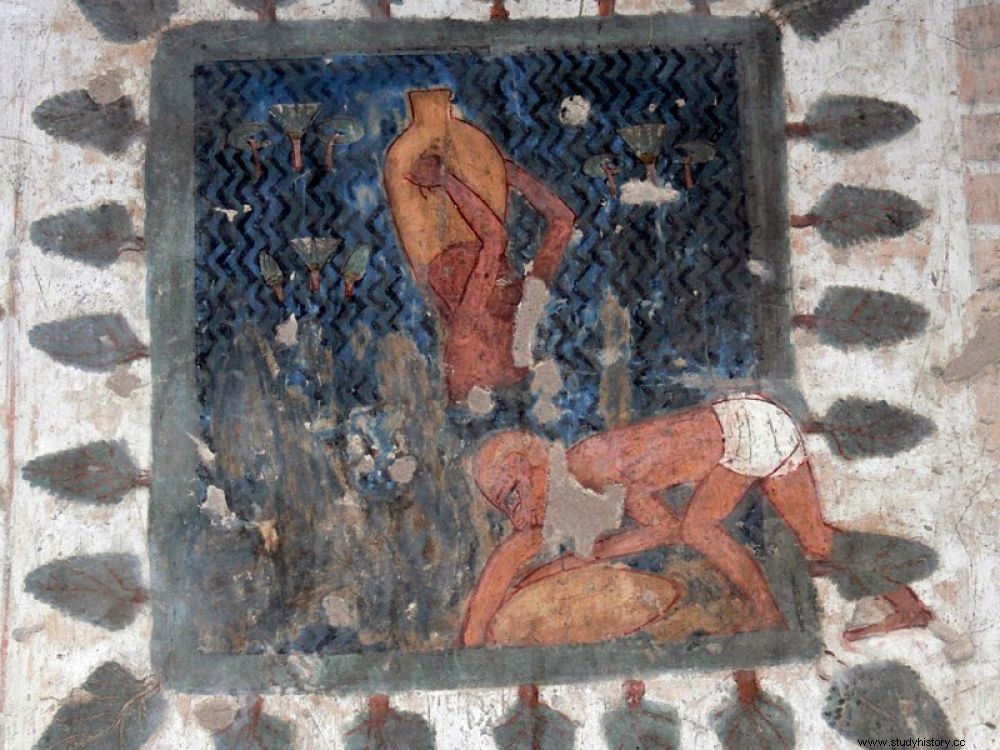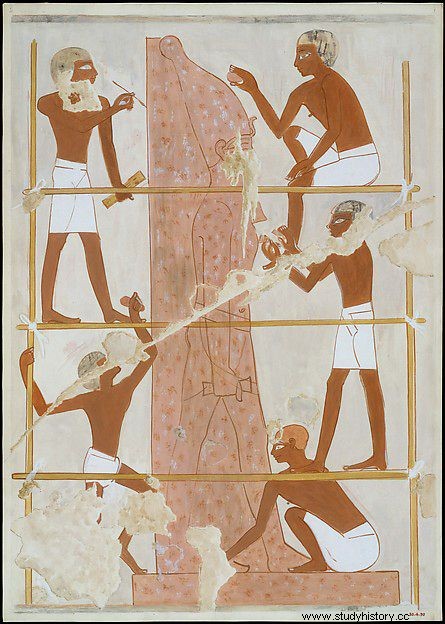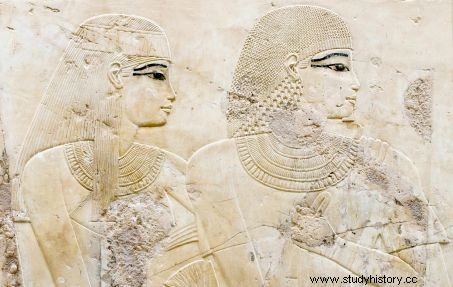For this 3rd episode of the Notebooks of Egypt, the analysis of the pigments used for the painting of the tombs of Luxor begins to be implemented. Some thoughts on the Egyptian palette.

Tomb of Rekhmire, Luxor. Representation of lake.
The ancient Egyptian always lived in a world filled with color. Color revealed all around him by the vibrant solar radiation which marks Egypt with its powerful seal. From his first artistic creations, in protohistoric times, the decorator used the colored materials that nature made available to him to bring to life the symbolic universe in which the elite projected themselves. Indeed, for him, color is life. The sculptor is called "séankh", "the one who gives life". But he does not give life simply by extracting a figure from a block of stone or a piece of wood, but by adding to the sculpture, even the most monumental, in a final essential step, the colors which give it appearance of life and who actually anime.
Among the "outline scribes" that we know, some have an extremely specialized task that relates to the sacred aspect of what they must magically bring to life. Thus Samut is "the Superior of the Scribes of the outline in the monuments of Amun at Karnak, the one who paints the great name of the Perfect God in the Castle of Usermaâtrê Sétepenrê in the domain of Amun in the West of Thebes" . In other words, this artist was in charge of coloring the cartouches of Ramses II throughout the Ramesseum, giving them through his talent a semi-divine life since they carry the very essence of royalty.
But what strikes us the most as modern viewers is the shimmering appearance of these sets when, by some extraordinary chance, they are still preserved. For the modern viewer too, this color brings life, but it actually reveals a codified life right down to its colors where green symbolizes regeneration, black is fertile land, blue the color of the Nile but also of the sky, where there is also a celestial Nile populated by yellow five-pointed stars which are undoubtedly starfish. The paintings strike us in a whirlwind of colors which is however only extremely limited in the means used.

Tomb of Rekhmire, Luxor. Scene of making a granite statue, top left, a painter at work. From a drawing by Norman de Garis Davies (1935). © LAMS-MAFTO, CNRS
"The pigments used are relatively low in number"
The scientific analyzes that have been carried out on murals, sarcophagi, sculptures and papyri show that the painters of ancient Egypt used a limited number of pigments. For the New Kingdom period, carbon black, red, brown and yellow earths tinted with iron oxides and arsenic compounds, were supplemented with some white pigments. To this natural palette were added two synthetic compounds:the blue and green pigments were synthesized by heating, in an oven, a mixture of copper, sand, limestone and ash:around 850 degrees, the blue is formed, then it breaks down when the oven gets even hotter to provide the green.
The very advanced know-how that it was essential to master to manufacture these pigments implies the existence of production workshops capable of supplying the quantities necessary for the decoration of tombs and other buildings. It has been estimated that 1400 kilos of blue pigments were needed to decorate a temple. Such workshops were found in 1892 by the Egyptologist Flinders Petrie on the site of Tell-el-Amarna. "In several scenes from the tomb of Rekhmire, the vizier of Thutmose III, the study of which began today, the choices and mixtures of pigments make it possible to prepare the acid yellow color used for a female representation. On the opposite wall, I perceive the ripples of the water in the representation of a garden pond. This graphic effect is also linked to the reliefs of the layout generated by the use of Egyptian blue in the form of large grains of a few tenths of a millimeter in diameter" , observes Catherine Defeyt, researcher at the European Center for Archaeometry at the University of Liège. On the other hand, this representation of ripples repeated three times means in hieroglyphics "water".
"The Egyptians used other pigments for eye makeup"
Other pigments could have been used but it seems that they were never favored by tomb painters. For eye makeup, black was indeed generally obtained with a lead ore, galena. Such a shadow was not described as a black pigment, but as a “powder to make the eye expressive” :when its grinding is carried out in a prolonged manner to form very small grains, its color is black; when the grains are larger, their facets reflect the light and a gray powder with metallic reflections is obtained. Sometimes, green makeup was also used:it was then natural copper-based minerals, such as malachite. Beyond their aesthetic qualities, these eyeshadows also had undeniable ophthalmological qualities and made it possible to combine business with pleasure.

Tomb of Ramose, Luxor, scene of the family banquet:only the make-up has been painted. © LAMS-MAFTO, CNRS
Notebooks of Egypt, 1st episode:how did the painters of ancient Egypt work?
Notebooks from Egypt, 2nd episode:Discovering the funeral chapel of Nakhtamon.
Notebooks from Egypt, 3rd episode:The pigments of Egyptian painting.
Notebooks from Egypt, 4th episode:The modern documentation of painted walls.
Notebooks from Egypt, 5th episode:Rediscovering the monuments of eternity of Ramses II.
Notebooks from Egypt, 6th episode:Revealing pigments with light:the visible and the invisible.
Notebooks from Egypt, 7th episode:Experiencing research through images.
Notebooks of Egypt, 8th episode:Beginning of the study of the paintings of the tomb of Nebamon and Ipouky.
Notebooks from Egypt, 9th episode:A tomb shared by two artists under Amenhotep III.
Notebooks from Egypt, 10th episode:What the tomb of Amenouahsou, an artist from ancient Egypt, reveals.
Notebooks from Egypt, 11th episode:Strange uses that have been made of Egyptian mummies.
Notebooks from Egypt, 12th episode:"Why don't all the artists come here?"
Notebooks of Egypt, 13th episode:Why did the Egyptians draw the characters in profile?
Notebooks from Egypt, 14th episode:Observing craft practices in Egyptian tombs.
Notebooks from Egypt, 15th episode:About Egyptian perfumes.
Notebooks from Egypt, 16th episode:The colors of the Egyptian palette.
Notebooks of Egypt, 17th episode:The Egyptian language does not know a word to designate "art".
Notebooks of Egypt, 18th episode:The day of a scientific mission in Egypt.
